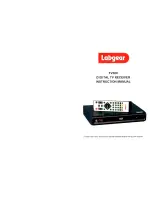
Venue Wideband Receiver
LECTROSONICS, INC.
14
When any Compat Mode other than Dig. Hybrid is se-
lected, FIXED will automatically be selected.
In this example, receiver modules 4, 5 and 6 are set to
the FIXED mode with no adjustment available.
Selecting Diversity Modes
Navigate to the DivMode setup screen.
Two diversity reception modes are available:
•
Switched Diversity
uses one receiver module per
audio channel.
•
Ratio Diversity (OptiBlend
TM
)
uses two receiver
modules per audio channel.
Press the Receiver Select Buttons to enter the setup
screens for the receiver modules.
Switched Diversity
In this mode the signals from both antennas are com-
bined into a single receiver module, with the phase of
one of them inverted back and forth so that they always
add to one another. The process reduces dropouts and
provides a stronger signal than a single antenna.
Ratio Diversity (OptiBlend
TM
)
Ratio diversity uses two adjacent receiver modules to
pick up a single transmitter. The audio outputs of the
modules are blended (mixed) together, using more or
less audio from each module based upon which module
has the stronger RF signal.
Ratio diversity anticipates dropouts before they occur,
rather than waiting until the RF signal level is very weak
and on the verge of noise or dropout. The comparison
of the RF signal levels in the modules begins when the
RF level is still high, so the circuit can blend in more
audio from the module with the stronger signal before
the signal decays enough to cause noise.
The blending action is smooth and seamless to avoid
any audible artifacts that can occur with abrupt switch-
ing. Most of the time both receiver modules have good
signals, so the audio is blended equally, which improves
the signal to noise ratio by 3 dB.
The blended audio appears at the rear panel XLR out-
puts of both modules.
Selecting the Tuning Mode
Pre-coordinated tuning groups are stored in memory to
simplify frequency coordination. The groups are labeled
GROUP a, b, c and d on the LCD, with eight frequen-
cies stored in each one. Refer to the section near the
back of this manual entitled Pre-coordinated Frequen-
cies for details on compatibility and using these groups.
Select a
through d
Three additional modes are also available to enable
compatibility with non-standard transmitters and storing
custom frequency sets. Navigate to the Tuning menu
and press the MENU/SELECT control.
NORMAL MODE
is the standard Lectrosonics mode
with 256 frequencies in 100 kHz steps. A unique pilot
tone is present for each frequency.
FINE MODE
allows tuning to 1024 frequencies in
25 kHz steps for compatibility with older and non-
Lectrosonics transmitters. Pilot tone frequency is set to
the next lower even 100kHz frequency. For example,
650.000, 650.025, 650.050 and 650.075 all use the
same pilot tone frequency.















































